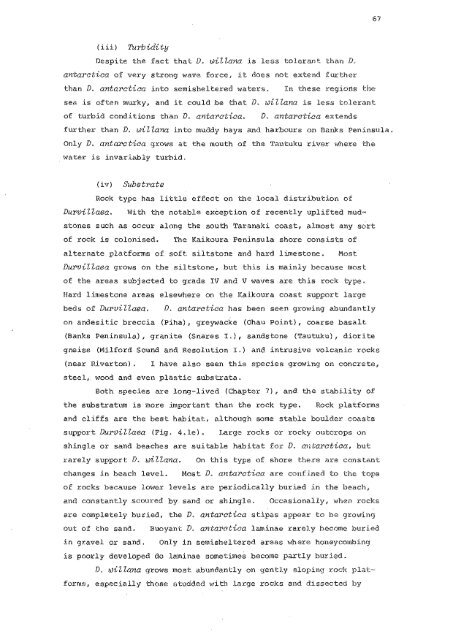A biological study of Durvillaea antarctica (Chamisso) Hariot and D ...
A biological study of Durvillaea antarctica (Chamisso) Hariot and D ...
A biological study of Durvillaea antarctica (Chamisso) Hariot and D ...
You also want an ePaper? Increase the reach of your titles
YUMPU automatically turns print PDFs into web optimized ePapers that Google loves.
67<br />
(iii) Turbidity<br />
Despite the fact that D. wiZZana is less tolerant than D.<br />
<strong>antarctica</strong> <strong>of</strong> very strong wave force, it does not extend further<br />
than D. <strong>antarctica</strong> into semisbeltered waters. In 'c.hese regions {~he<br />
sea is <strong>of</strong>ten murky, <strong>and</strong> it could be that Do willana is less tDlerant<br />
<strong>of</strong> turbid conditions than D. <strong>antarctica</strong>. D, <strong>antarctica</strong> e~ctends<br />
further than D. willana into muddy bays <strong>and</strong> harbours on Bal~s Peninsula.<br />
Only D. anta:r>ctica grows at t.he moutb <strong>of</strong> the Tautuku :eiver. where the<br />
~..rate:r<br />
is invariably turhid,<br />
(iv)<br />
Substrate<br />
Rock type has little effect on the local distribution <strong>of</strong><br />
Dur-villaea. with the notable exception <strong>of</strong> recently uplifted mud~<br />
stones such as occur along the south Taranaki coast, almost any sort<br />
<strong>of</strong> rock is colonised. The Kaikoura Peninsula shore consists <strong>of</strong><br />
alternate platforms <strong>of</strong> s<strong>of</strong>t siltstone <strong>and</strong> hard limestone. Most<br />
DurviZZaea grows on the siltstone, but this is mainly because most<br />
<strong>of</strong> the areas subjected to grade IV <strong>and</strong> V waves are this rock type,<br />
Hard limestone areas elsewhere on the Kaikoura coast support large<br />
beds <strong>of</strong> DurvilZaea, D. <strong>antarctica</strong> has been seen gro",ing abundantly<br />
on <strong>and</strong>esitic breccia (Piha), greywacke (Ohau Point), coarse basalt<br />
(Banks peninsula.) , granite (Snares I.), s<strong>and</strong>stone (Tautuku), diorite<br />
gneiss (Milford Sound <strong>and</strong> Resolution I.) <strong>and</strong> intrusive volcanic rocks<br />
(near Riverton) . I have also seen this species growing on concrete,<br />
steel, wood <strong>and</strong> even plastic substrata.<br />
Both species are long-lived (Chapter 7), <strong>and</strong> the stability <strong>of</strong><br />
the substratum is more important than the rock type. Rock platforms<br />
<strong>and</strong> cliffs are tbe best habitat, nlthough some stable boulder coast.s<br />
support <strong>Durvillaea</strong> (Fig. 4.le). Large rocks or rocky outcrops 0n<br />
shingle or s<strong>and</strong> beaches are suitable habitat for D. m~taX'ctica, but<br />
rarely support D. wiZlana. On this type <strong>of</strong> shore there are constant<br />
changes in beach level. Most D. antal'ctica are confined to tbe tops<br />
<strong>of</strong> rocks because lower levels axe periodically buried in the beach"<br />
cnd constantly scoured by s<strong>and</strong> or shingle. Occasionally, when rocks<br />
are completely buried, the D. <strong>antarctica</strong> stipes appear to be growing<br />
out <strong>of</strong> the s<strong>and</strong>" Buoyant D, antal'ctica laminae rarely become buried<br />
in gxavel or s<strong>and</strong>. Only in semiahel'tered areas ,.;here honeycombing<br />
is poorly developed do laminae sometimes become partly buried.<br />
D, wiZZana grows most abundantly on gently sloping rock plat-'<br />
forms, especially those studded "lith large rocks <strong>and</strong> dissected by
















